International Business - Culture, Communication, and Globalization
VerifiedAdded on 2022/09/26
|6
|1184
|19
Essay
AI Summary
This essay examines the significant role of culture in international business, focusing on two key areas: the cultural practice of veiling among Muslim women and the impact of globalization on cultural exchange, specifically using the example of McDonald's in Japan. The first part of the essay discusses the complexities surrounding the practice of veiling, addressing the cultural significance, misconceptions, and the importance of respecting individual choices within the Muslim community. It challenges the generalization that all Muslim women are forced to veil and emphasizes that this is a matter of personal choice. The second part analyzes the interaction and borrowing between different civilizations through the lens of McDonald's in Japan, demonstrating how globalization leads to the incorporation of local elements and the evolution of cultural practices. The essay highlights how the introduction of McDonald's has influenced Japanese eating habits, and how the Japanese market has incorporated Japanese food items into the menu. It argues that interaction and communication between civilizations are important for successful business growth and cultural exchange.
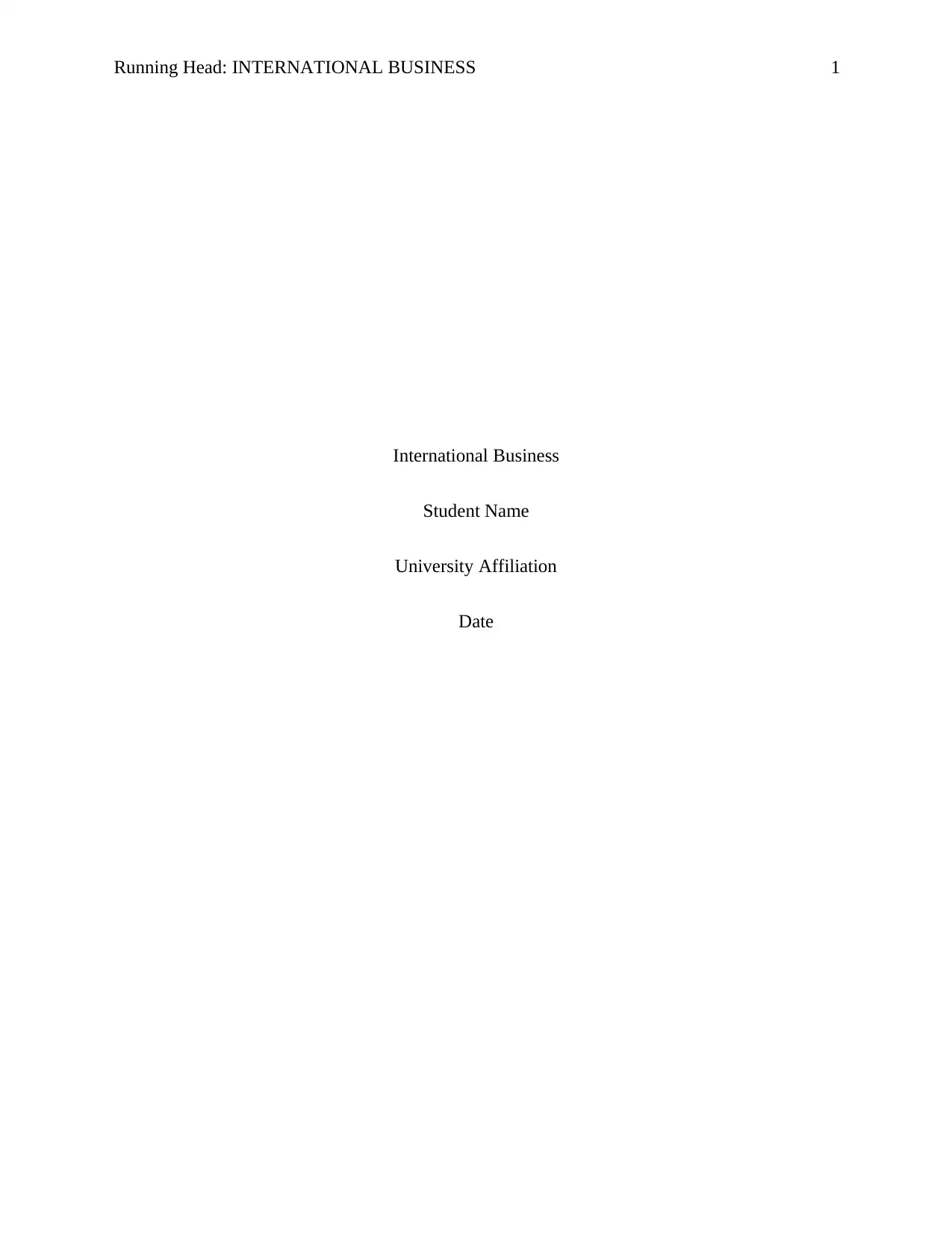
Running Head: INTERNATIONAL BUSINESS 1
International Business
Student Name
University Affiliation
Date
International Business
Student Name
University Affiliation
Date
Paraphrase This Document
Need a fresh take? Get an instant paraphrase of this document with our AI Paraphraser
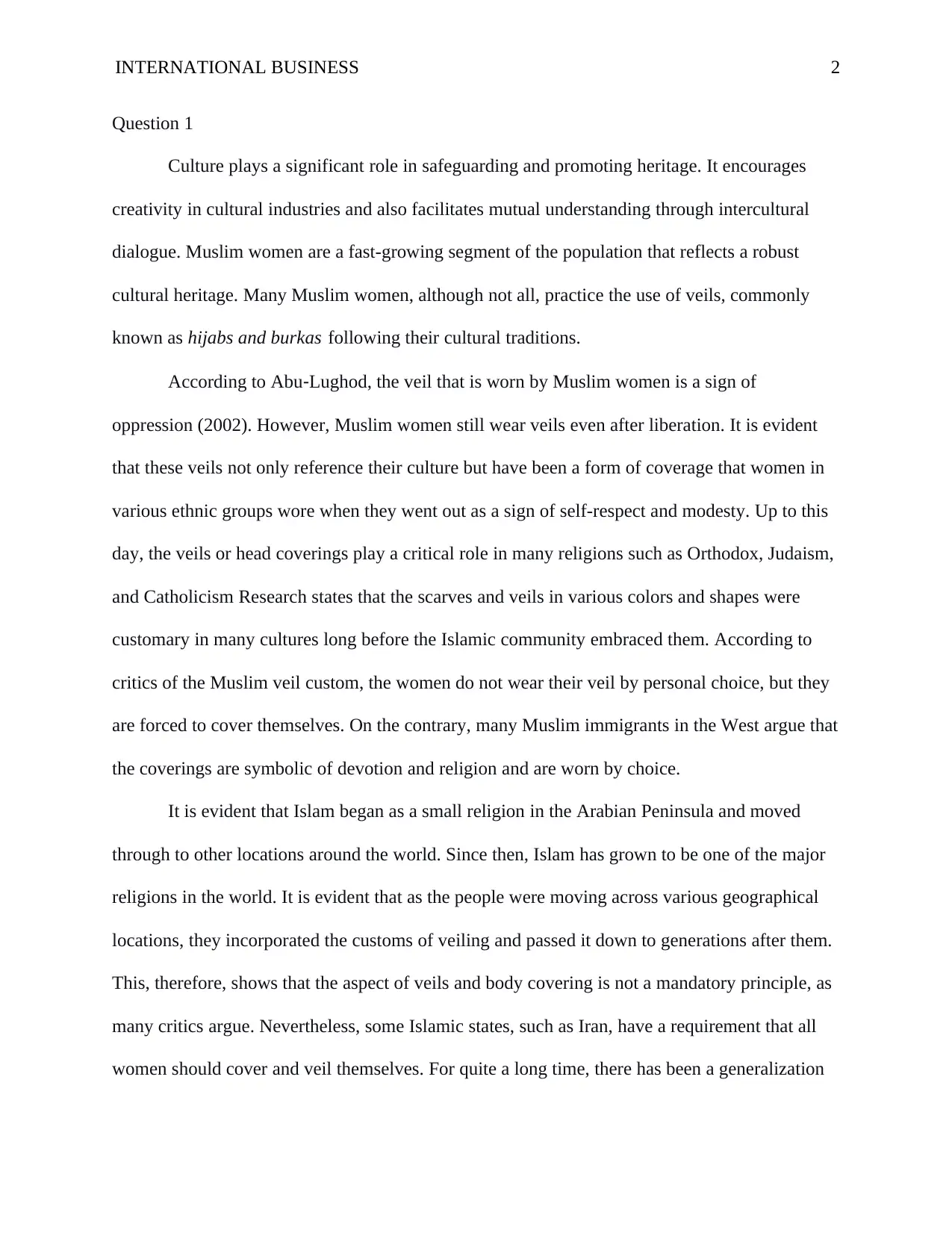
INTERNATIONAL BUSINESS 2
Question 1
Culture plays a significant role in safeguarding and promoting heritage. It encourages
creativity in cultural industries and also facilitates mutual understanding through intercultural
dialogue. Muslim women are a fast-growing segment of the population that reflects a robust
cultural heritage. Many Muslim women, although not all, practice the use of veils, commonly
known as hijabs and burkas following their cultural traditions.
According to Abu‐Lughod, the veil that is worn by Muslim women is a sign of
oppression (2002). However, Muslim women still wear veils even after liberation. It is evident
that these veils not only reference their culture but have been a form of coverage that women in
various ethnic groups wore when they went out as a sign of self-respect and modesty. Up to this
day, the veils or head coverings play a critical role in many religions such as Orthodox, Judaism,
and Catholicism Research states that the scarves and veils in various colors and shapes were
customary in many cultures long before the Islamic community embraced them. According to
critics of the Muslim veil custom, the women do not wear their veil by personal choice, but they
are forced to cover themselves. On the contrary, many Muslim immigrants in the West argue that
the coverings are symbolic of devotion and religion and are worn by choice.
It is evident that Islam began as a small religion in the Arabian Peninsula and moved
through to other locations around the world. Since then, Islam has grown to be one of the major
religions in the world. It is evident that as the people were moving across various geographical
locations, they incorporated the customs of veiling and passed it down to generations after them.
This, therefore, shows that the aspect of veils and body covering is not a mandatory principle, as
many critics argue. Nevertheless, some Islamic states, such as Iran, have a requirement that all
women should cover and veil themselves. For quite a long time, there has been a generalization
Question 1
Culture plays a significant role in safeguarding and promoting heritage. It encourages
creativity in cultural industries and also facilitates mutual understanding through intercultural
dialogue. Muslim women are a fast-growing segment of the population that reflects a robust
cultural heritage. Many Muslim women, although not all, practice the use of veils, commonly
known as hijabs and burkas following their cultural traditions.
According to Abu‐Lughod, the veil that is worn by Muslim women is a sign of
oppression (2002). However, Muslim women still wear veils even after liberation. It is evident
that these veils not only reference their culture but have been a form of coverage that women in
various ethnic groups wore when they went out as a sign of self-respect and modesty. Up to this
day, the veils or head coverings play a critical role in many religions such as Orthodox, Judaism,
and Catholicism Research states that the scarves and veils in various colors and shapes were
customary in many cultures long before the Islamic community embraced them. According to
critics of the Muslim veil custom, the women do not wear their veil by personal choice, but they
are forced to cover themselves. On the contrary, many Muslim immigrants in the West argue that
the coverings are symbolic of devotion and religion and are worn by choice.
It is evident that Islam began as a small religion in the Arabian Peninsula and moved
through to other locations around the world. Since then, Islam has grown to be one of the major
religions in the world. It is evident that as the people were moving across various geographical
locations, they incorporated the customs of veiling and passed it down to generations after them.
This, therefore, shows that the aspect of veils and body covering is not a mandatory principle, as
many critics argue. Nevertheless, some Islamic states, such as Iran, have a requirement that all
women should cover and veil themselves. For quite a long time, there has been a generalization
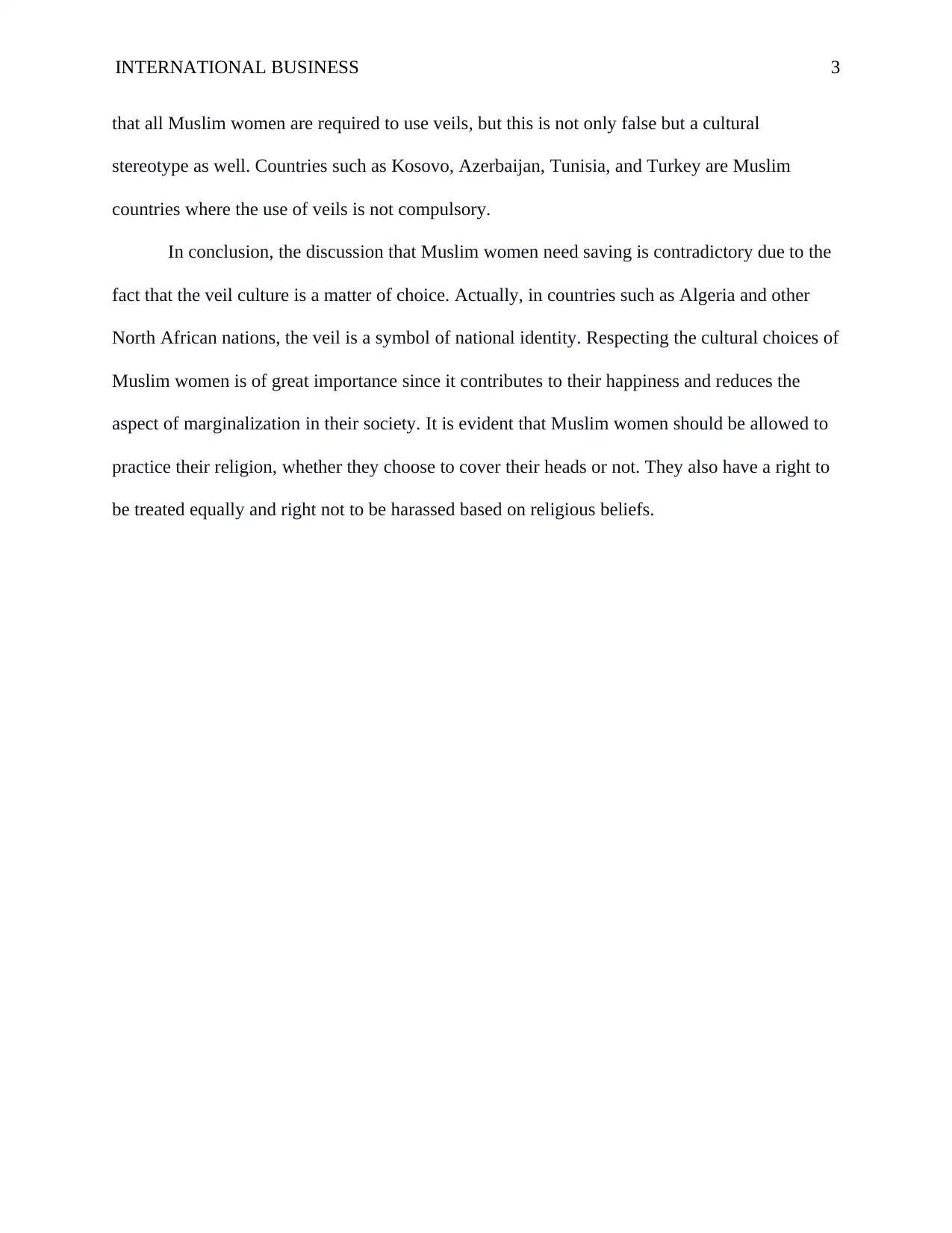
INTERNATIONAL BUSINESS 3
that all Muslim women are required to use veils, but this is not only false but a cultural
stereotype as well. Countries such as Kosovo, Azerbaijan, Tunisia, and Turkey are Muslim
countries where the use of veils is not compulsory.
In conclusion, the discussion that Muslim women need saving is contradictory due to the
fact that the veil culture is a matter of choice. Actually, in countries such as Algeria and other
North African nations, the veil is a symbol of national identity. Respecting the cultural choices of
Muslim women is of great importance since it contributes to their happiness and reduces the
aspect of marginalization in their society. It is evident that Muslim women should be allowed to
practice their religion, whether they choose to cover their heads or not. They also have a right to
be treated equally and right not to be harassed based on religious beliefs.
that all Muslim women are required to use veils, but this is not only false but a cultural
stereotype as well. Countries such as Kosovo, Azerbaijan, Tunisia, and Turkey are Muslim
countries where the use of veils is not compulsory.
In conclusion, the discussion that Muslim women need saving is contradictory due to the
fact that the veil culture is a matter of choice. Actually, in countries such as Algeria and other
North African nations, the veil is a symbol of national identity. Respecting the cultural choices of
Muslim women is of great importance since it contributes to their happiness and reduces the
aspect of marginalization in their society. It is evident that Muslim women should be allowed to
practice their religion, whether they choose to cover their heads or not. They also have a right to
be treated equally and right not to be harassed based on religious beliefs.
⊘ This is a preview!⊘
Do you want full access?
Subscribe today to unlock all pages.

Trusted by 1+ million students worldwide
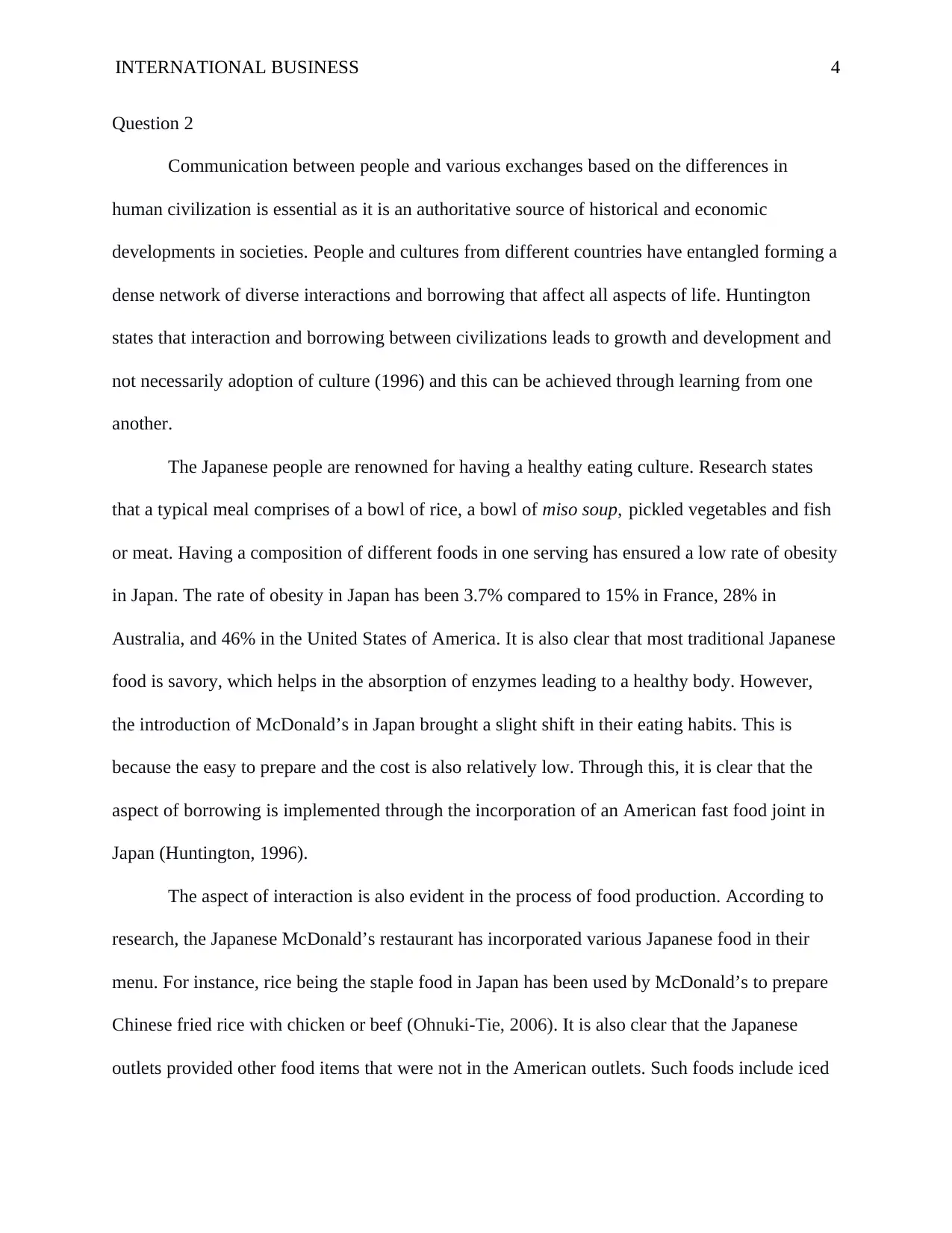
INTERNATIONAL BUSINESS 4
Question 2
Communication between people and various exchanges based on the differences in
human civilization is essential as it is an authoritative source of historical and economic
developments in societies. People and cultures from different countries have entangled forming a
dense network of diverse interactions and borrowing that affect all aspects of life. Huntington
states that interaction and borrowing between civilizations leads to growth and development and
not necessarily adoption of culture (1996) and this can be achieved through learning from one
another.
The Japanese people are renowned for having a healthy eating culture. Research states
that a typical meal comprises of a bowl of rice, a bowl of miso soup, pickled vegetables and fish
or meat. Having a composition of different foods in one serving has ensured a low rate of obesity
in Japan. The rate of obesity in Japan has been 3.7% compared to 15% in France, 28% in
Australia, and 46% in the United States of America. It is also clear that most traditional Japanese
food is savory, which helps in the absorption of enzymes leading to a healthy body. However,
the introduction of McDonald’s in Japan brought a slight shift in their eating habits. This is
because the easy to prepare and the cost is also relatively low. Through this, it is clear that the
aspect of borrowing is implemented through the incorporation of an American fast food joint in
Japan (Huntington, 1996).
The aspect of interaction is also evident in the process of food production. According to
research, the Japanese McDonald’s restaurant has incorporated various Japanese food in their
menu. For instance, rice being the staple food in Japan has been used by McDonald’s to prepare
Chinese fried rice with chicken or beef (Ohnuki-Tie, 2006). It is also clear that the Japanese
outlets provided other food items that were not in the American outlets. Such foods include iced
Question 2
Communication between people and various exchanges based on the differences in
human civilization is essential as it is an authoritative source of historical and economic
developments in societies. People and cultures from different countries have entangled forming a
dense network of diverse interactions and borrowing that affect all aspects of life. Huntington
states that interaction and borrowing between civilizations leads to growth and development and
not necessarily adoption of culture (1996) and this can be achieved through learning from one
another.
The Japanese people are renowned for having a healthy eating culture. Research states
that a typical meal comprises of a bowl of rice, a bowl of miso soup, pickled vegetables and fish
or meat. Having a composition of different foods in one serving has ensured a low rate of obesity
in Japan. The rate of obesity in Japan has been 3.7% compared to 15% in France, 28% in
Australia, and 46% in the United States of America. It is also clear that most traditional Japanese
food is savory, which helps in the absorption of enzymes leading to a healthy body. However,
the introduction of McDonald’s in Japan brought a slight shift in their eating habits. This is
because the easy to prepare and the cost is also relatively low. Through this, it is clear that the
aspect of borrowing is implemented through the incorporation of an American fast food joint in
Japan (Huntington, 1996).
The aspect of interaction is also evident in the process of food production. According to
research, the Japanese McDonald’s restaurant has incorporated various Japanese food in their
menu. For instance, rice being the staple food in Japan has been used by McDonald’s to prepare
Chinese fried rice with chicken or beef (Ohnuki-Tie, 2006). It is also clear that the Japanese
outlets provided other food items that were not in the American outlets. Such foods include iced
Paraphrase This Document
Need a fresh take? Get an instant paraphrase of this document with our AI Paraphraser
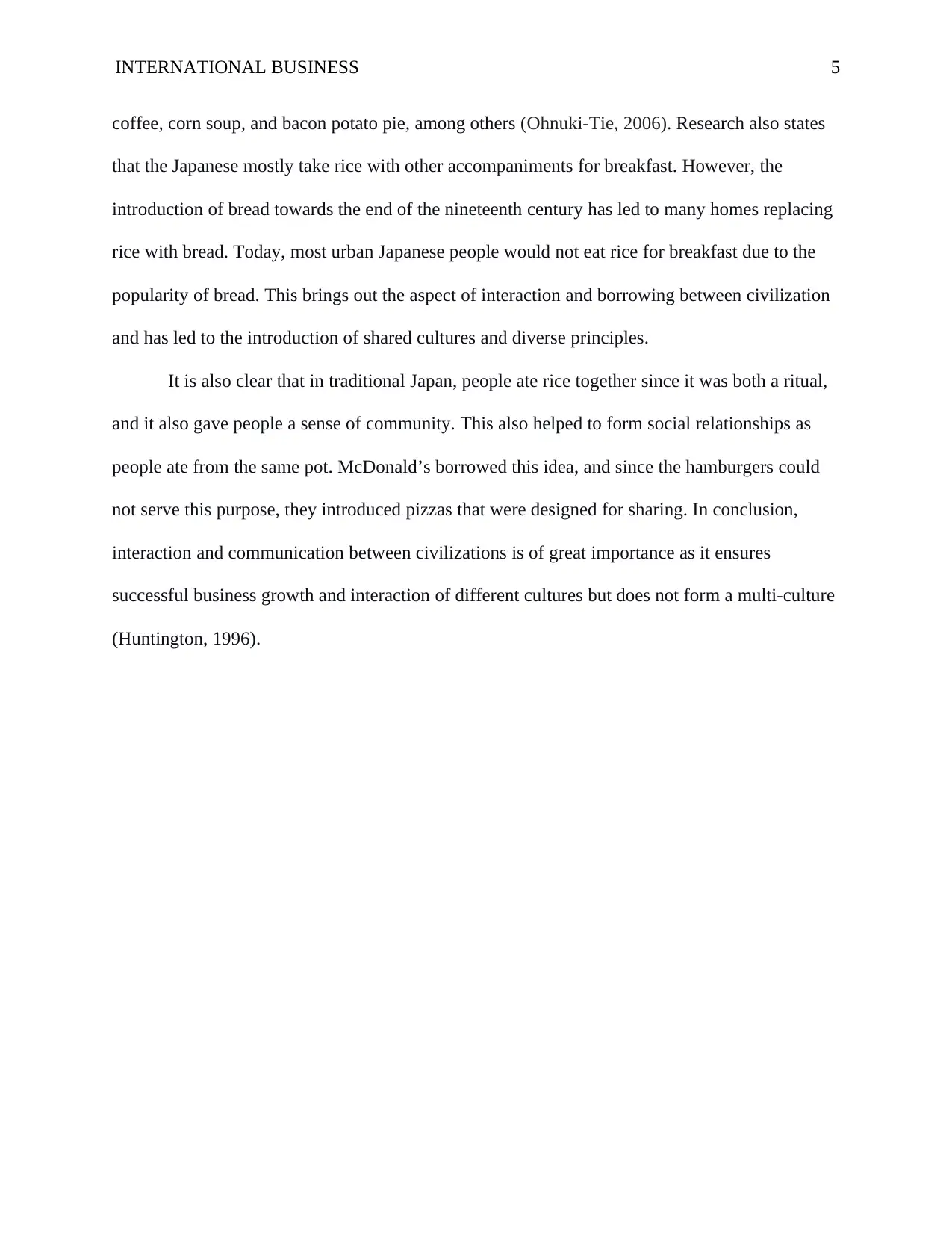
INTERNATIONAL BUSINESS 5
coffee, corn soup, and bacon potato pie, among others (Ohnuki-Tie, 2006). Research also states
that the Japanese mostly take rice with other accompaniments for breakfast. However, the
introduction of bread towards the end of the nineteenth century has led to many homes replacing
rice with bread. Today, most urban Japanese people would not eat rice for breakfast due to the
popularity of bread. This brings out the aspect of interaction and borrowing between civilization
and has led to the introduction of shared cultures and diverse principles.
It is also clear that in traditional Japan, people ate rice together since it was both a ritual,
and it also gave people a sense of community. This also helped to form social relationships as
people ate from the same pot. McDonald’s borrowed this idea, and since the hamburgers could
not serve this purpose, they introduced pizzas that were designed for sharing. In conclusion,
interaction and communication between civilizations is of great importance as it ensures
successful business growth and interaction of different cultures but does not form a multi-culture
(Huntington, 1996).
coffee, corn soup, and bacon potato pie, among others (Ohnuki-Tie, 2006). Research also states
that the Japanese mostly take rice with other accompaniments for breakfast. However, the
introduction of bread towards the end of the nineteenth century has led to many homes replacing
rice with bread. Today, most urban Japanese people would not eat rice for breakfast due to the
popularity of bread. This brings out the aspect of interaction and borrowing between civilization
and has led to the introduction of shared cultures and diverse principles.
It is also clear that in traditional Japan, people ate rice together since it was both a ritual,
and it also gave people a sense of community. This also helped to form social relationships as
people ate from the same pot. McDonald’s borrowed this idea, and since the hamburgers could
not serve this purpose, they introduced pizzas that were designed for sharing. In conclusion,
interaction and communication between civilizations is of great importance as it ensures
successful business growth and interaction of different cultures but does not form a multi-culture
(Huntington, 1996).
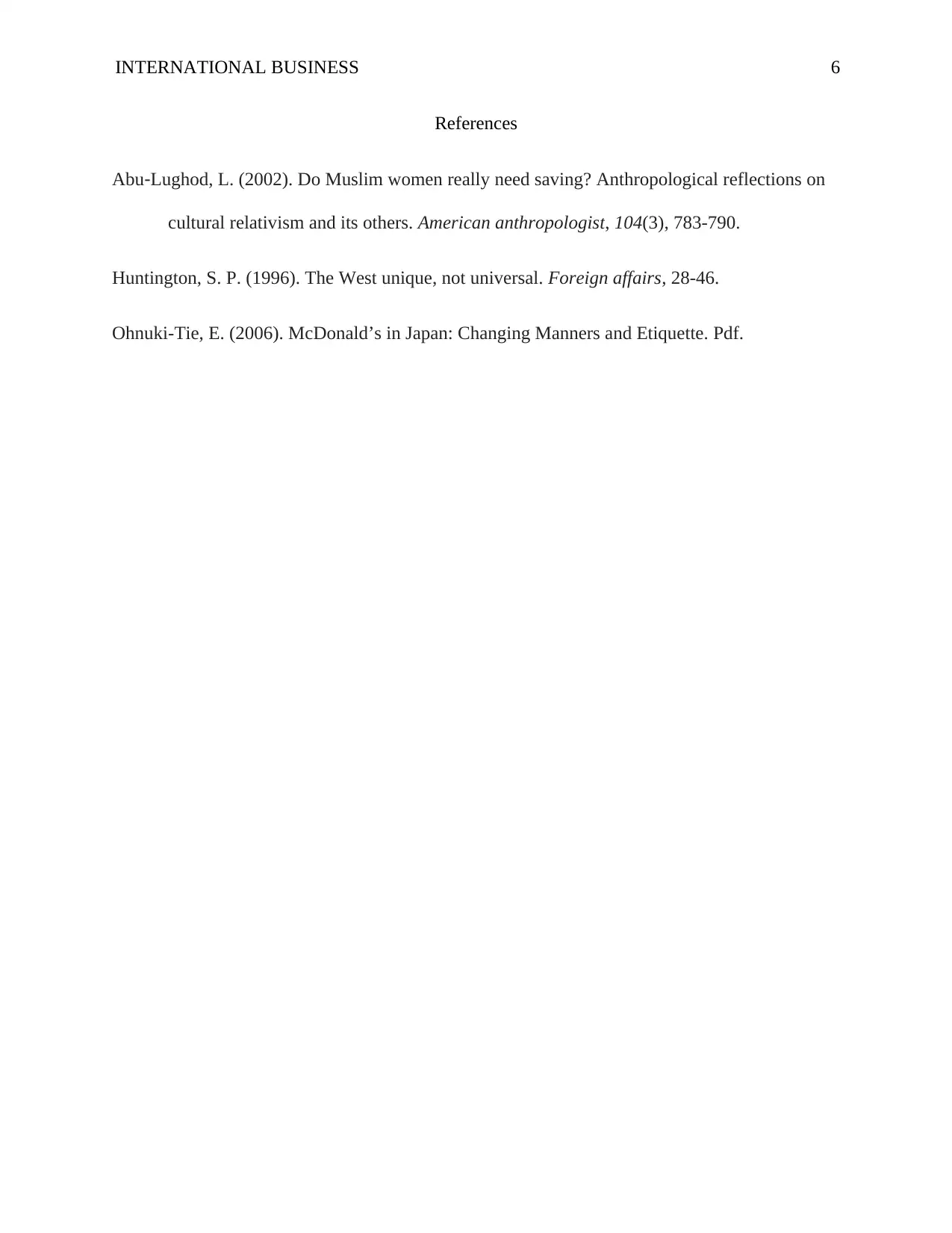
INTERNATIONAL BUSINESS 6
References
Abu‐Lughod, L. (2002). Do Muslim women really need saving? Anthropological reflections on
cultural relativism and its others. American anthropologist, 104(3), 783-790.
Huntington, S. P. (1996). The West unique, not universal. Foreign affairs, 28-46.
Ohnuki-Tie, E. (2006). McDonald’s in Japan: Changing Manners and Etiquette. Pdf.
References
Abu‐Lughod, L. (2002). Do Muslim women really need saving? Anthropological reflections on
cultural relativism and its others. American anthropologist, 104(3), 783-790.
Huntington, S. P. (1996). The West unique, not universal. Foreign affairs, 28-46.
Ohnuki-Tie, E. (2006). McDonald’s in Japan: Changing Manners and Etiquette. Pdf.
⊘ This is a preview!⊘
Do you want full access?
Subscribe today to unlock all pages.

Trusted by 1+ million students worldwide
1 out of 6
Related Documents
Your All-in-One AI-Powered Toolkit for Academic Success.
+13062052269
info@desklib.com
Available 24*7 on WhatsApp / Email
![[object Object]](/_next/static/media/star-bottom.7253800d.svg)
Unlock your academic potential
Copyright © 2020–2025 A2Z Services. All Rights Reserved. Developed and managed by ZUCOL.





